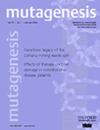纳米氧化钴(Co3O4)通过调节活性氧诱导中国仓鼠肺成纤维细胞(V79)遗传毒性。
IF 2.5
4区 医学
Q3 GENETICS & HEREDITY
引用次数: 2
摘要
钴氧化物纳米粒子(Co3O4 NPs)的不断生产,在不同领域的广泛应用,以及最终意外暴露,导致其对人类健康的毒性研究增加。然而,关于Co3O4 NPs的潜在毒性机制,特别是遗传毒性的信息仍然很少,缺乏相互联系。到目前为止,只有关于Co3O4 NPs的单独报道,见证了活性氧(ROS)介导的肺细胞DNA损伤。为了解决这个问题,我们评估了Co3O4 np诱导的中国仓鼠肺成纤维细胞系(V79)的细胞毒性和基因毒性潜力。我们的初步结果表明,浓度为20-100 μ g/ml的Co3O4 NPs在暴露24小时后可引起中度死亡。然而,这些低浓度以浓度依赖的方式引起各种细胞器活性的显着降低。发现线粒体活性和膜电位由于NP暴露以浓度依赖的方式受到损害。本研究证实Co3O4 NPs抑制V79细胞溶酶体活性。此外,还发现Co3O4 NPs可以刺激自由基的产生。遗传毒性研究显示,非细胞毒性浓度的Co3O4 NPs在诱导DNA损伤中具有强效和剂量依赖性作用。有趣的是,n -乙酰半胱氨酸,一种自由基清除剂(5,10 mM,预处理)抑制自由基的进展和诱导Co3O4 np介导的DNA损伤。这表明Co3O4 NPs具有ros介导的遗传毒性。本文章由计算机程序翻译,如有差异,请以英文原文为准。
Cobalt oxide (Co3O4) nanoparticles induced genotoxicity in Chinese hamster lung fibroblast (V79) cells through modulation of reactive oxygen species.
Incessant production, pervasive applications in different fields, and eventually unintended exposure of cobalt oxide nanoparticles (Co3O4 NPs) lead to rise in their toxicity studies toward human health. However, the information regarding the potential toxicity mechanisms of Co3O4 NPs especially genotoxicity is still sparse with missing interconnections. So far, only solitary reports on Co3O4 NPs are at hand, bearing witness to reactive oxygen species (ROS)-mediated DNA damage in lung cells. To address this, we evaluated the Co3O4 NP-induced cytotoxic and genotoxic potential in Chinese hamster lung fibroblast cell line (V79). Our preliminary results demonstrate that Co3O4 NPs at concentrations of 20-100 µg/ml induced moderate mortality after 24-h exposure. However, these low concentrations caused a significant reduction in various organelles' activity in a concentration-dependent manner. Mitochondrial activity and membrane potential were found to be compromised due to NP exposure in a concentration-dependent manner. The study affirms that Co3O4 NPs inhibited lysosomal activity in V79 cells. In addition to this, Co3O4 NPs are also found to stimulate free oxygen radical generation. Genotoxicity studies revealed a potent and dose-dependent effect of non-cytotoxic concentrations of Co3O4 NPs in the induction of DNA lesions. Interestingly, N-acetylcysteine, a free oxygen radical scavenger (5, 10 mM, pretreatment) inhibited the progression of free oxygen radicals and induction of Co3O4 NP-mediated DNA lesions. This suggests the ROS-mediated genotoxic potential of Co3O4 NPs.
求助全文
通过发布文献求助,成功后即可免费获取论文全文。
去求助
来源期刊

Mutagenesis
生物-毒理学
CiteScore
5.90
自引率
3.70%
发文量
22
审稿时长
6-12 weeks
期刊介绍:
Mutagenesis is an international multi-disciplinary journal designed to bring together research aimed at the identification, characterization and elucidation of the mechanisms of action of physical, chemical and biological agents capable of producing genetic change in living organisms and the study of the consequences of such changes.
 求助内容:
求助内容: 应助结果提醒方式:
应助结果提醒方式:


